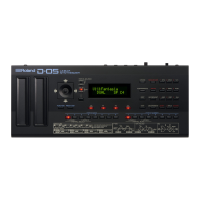37
MIDI Implementation
7 Request data 1 “RQ1” (11H)
Transmit this when you want the other device to send you data. The address and size indicate the
size of data that is requested.
If this message is received, and if that device is able to transmit data, and the address and size are
appropriate, the requested data is sent as a “data reset” message. If these conditions are not met,
nothing is sent.
Byte Explanation
F0H Exclusive status
41H Roland ID
DEV Device-ID
14H Model-ID (D-50)
11H Command-ID
aaH Address MSB
LSB
ssH Size MSB
LSB
sum Check Sum
F7H EOX (End Of Exclusive)
* The size indicates the address of the entire data that is being requested; it is not the number of
bytes of data in a single “data set 1” message.
* For each model, the amount of data that can be transmitted at one time is xed depending on
the type of data, and in some cases the data must be transmitted and received in divisions of the
specied address.
* The address and size are the same numbers of bytes, and are determined for each “model ID.”
* The check sum is the value that causes the lower seven bits to be zero when the address, the
size, and the check sum itself are added.
7 Data set 1 “DT1” (12H)
This transmits the actual data.
Although each individual byte of data has an address, this message allows the address of a single
item of data, or the starting address of multiple items of data, together with the data alone, to be
transmitted in the order of the addresses.
According to the MIDI specication, messages other than realtime messages cannot interrupt an
exclusive message. In consideration of devices that implement “soft-thru,” Roland limits the amount
of data that is transferred in a single “data set 1” to a maximum of 256 bytes; for this reason, large
amount of data that exceed 256 bytes are divided and transmitted in multiple pieces.
Byte Explanation
F0H Exclusive status
41H Roland ID
DEV Device-ID
14H Model-ID (D-50)
12H Command-ID
aaH Address MSB
LSB
ssH Data
sum Check Sum
F7H EOX (End Of Exclusive)
* This message allows transfer of just the valid portion within the range indicated by the “data
request 1” message.
* For each model, the number of data items that can be transmitted at once is determined accord-
ing to the type of data, and in some cases, these must be transmitted or received at divisions of
the specied address.
* The number of address bytes is determined for each “model ID.”
* The check sum is the value that causes the lower seven bits to be zero when the address, the
size, and the check sum itself are added.
7 Example of transmission and reception
6
When device (A) transfers data to device (B)
Simply transmit a “data set 1” message.
Device A Device B
“Data set 1”
“Data set 1”
“Data set 1”
* Make a time interval of 20 msec or more
6
When device (B) requests data transmission from device (A)
First a “data request 1” message is transmitted. Then, device (A) transmits a “data set 1” message.
Device A Device B
“Data set 1”
“Request data”
“Data set 1”
“Data set 1”
* Make a time interval of 20 msec or more
9
3.4 Transferring Data Using the Handshake
Method
The handshake method transfers data while performing bi-directional verication between the two
devices. Since data is transferred while checking whether it was transferred correctly, it is highly
reliable, and since data is transmitted successively as soon as the receiving device is ready, data
transfer takes a shorter time than the one-way method which involves waiting for an interval of
time.
When transferring a large amount of MIDI data, such as sampler waveform data or data for all
sounds of a synthesizer, the handshake method is more appropriate than the one-way method.
Types of message
Byte Explanation
Want to send data WSD (40H)
Request data RQD (41H)
Data set DAT (42H)
Acknowiedge
ACK (43H)
End of data EOD (45H)
Communication
error
ERR (4EH)
Rejection RJC (4FH)
7 Want to send data “WSD” (40H)
Transmit this when you want to send data to the other device. The address and size indicate the
amount of data that you want to send.
If this message is received, and if that device is able to receive data, and the address and size are
appropriate, then it transmits an “acknowledge” message. If not, the device transmits a “ rejection”
message.
Byte Explanation
F0H Exclusive status
41H Roland ID
DEV Device-ID
14H Model-ID (D-50)
40H Command-ID
aaH Address MSB
LSB

